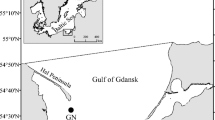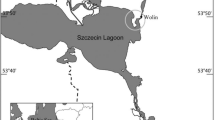Abstract
Wet weight to ash-free dry weight conversion factors were calculated for the bivalve Mytilus galloprovincialis Lamarck; specimens were collected in November 1989 in the Magra Estuary (eastern Ligurian Sea, Italy). Ash-free dry weight was determined by four different methods: (A) mechanical separation of shell and body; (B) shell dissolution with HCl; (C) dissolution of organic matter with NaClO; (D) incineration of the whole organism. The results obtained by these four methods were significantly different, indicating that caution is necessary when comparing biomass data obtained by different methods. Incineration and decalcification with HCl seem to be the best procedures: they not only combine accuracy with speed, but are also the most universally applicable, being equally suitable for soft-bodied or hard-bodied organisms. Mechanical separation can lead to an underestimation of the biomass, whereas treatment with NaClO can lead to its overestimation. However, no method can be considered the best in absolute terms, the final choice depending on the particular weight measurement required (e.g. shell-free dry weight) and the nature of the organism concerned (e.g. an organism with a large carbonate content).
Similar content being viewed by others
References
Banse K, Mosher S (1980) Adult body mass and annual production/biomass relationship of field populations. Ecol Monogr 50: 355–379
Boudreau PR, Dickie LM (1992) Biomass spectra of aquatic ecosystems in relation to fisheries yield. Can J Fish aquat Sciences 49: 1528–1538
Brey T (1990) Estimating productivity of macrobenthic invertebrates from biomass and mean individual weight. Meeresforsch Rep mar Res 32: 329–343 (Ber dt wiss Kommn Meeresforsch)
Brotskaja VA, Zenkevich LA (1939) Quantitative evaluation of the bottom fauna in the Barents Sea. Summary. Trudy vses nauchnoissled Inst morsk ryb Khoz Okeanogr 4: 99–126
Buffoni G, Bianchi GN, Delfanti R, Di Cola G, Morri C, Niccolai I, Peroni C (1990) Modello di reti trofiche in biocenosi bentiche. Applicazione a biocenosi del golfo di Gaeta. Atti Congr Ass ital Oceanol Limnol 8: 227–251 [Bregant D, Fanzutti GP (eds) A.I.O.L., Genova]
Castric-Fey A, Chassé C (1991) Factorial analysis in the ecology of rocky subtidal areas near Brest (West Brittany, France). J mar biol Ass UK 71: 515–536
Crisp DJ (1984) Energy flow measurements. In: Holme NA, McIntyre AD (eds) Methods for the study of marine benthos. Blackwell Scientific. Oxford, pp 284–372
Edgar GJ (1990) The use of the size structure of benthic macrofaunal communities to estimate faunal biomass and secondary production. J exp mar Biol Ecol 137: 195–214
Giese AC (1967) Some methods for study of the biochemical constitution of marine invertebrates. Oceanogr mar Biol A Rev 5: 159–186
Gilat E (1969) Study of an ecosystem in the coastal waters of the Ligurian Sea, III. Macrobenthic communities. Bull Inst océanogr Monaco 69 (1396): 1–76
Grove EL, Jones RA, Mathews W (1961) The loss of sodium and potassium during the dry ashing of animal tissue. Analyt Biochem 2: 221–230
Lappalainen A, Kangas P (1975) Littoral benthos of the Northern Baltic Sea. II. Interrelationship of wet, dry and ash-free dry weight of macrofauna in the Tvarminne area. Int Revue ges Hydrobiol 60: 297–312
Lie U (1968) A quantitative study of benthic infauna in Puget Sound, Washington, USA, in 1963–1964. FiskDir Skr (Ser Havunders) 14: 229–556
Martinengo JR (1984) Relaciones entre unidades de volumen y unidades de biomasa en distintas especies de algas bentónicas. Aplicación a evaluaciones de biomasa del fitobenthos. Oecologia aquat 7: 37–42
Morri C, Castelli A, Diviacco G, Mori M, Bianchi CN (1990) Zonazione di comunità bentiche lungo l'estuario della Magra (Mar Ligure orientale). Memorie Soc tosc Sci nat (Ser B) 97: 311–327
Paine RT (1964) Ash and caloric determinations of sponge and opisthobranch tissues. Ecology 45: 384–387
Petersen CGJ (1918) The sea bottom and its production of fish-food. A survey of the work done in connection with valuation of the Danish waters from 1883–1917. Rep Dan biol Stn 25: 1–62
Rainer SF, Wadley VA (1991) Abundance, growth and production of the bivalve Solemya sp., a food source for juvenile rock lobsters in a seagrass community in Western Australia. J exp mar Biol Ecol 152: 201–223
Richards NJ, Richards SW (1965) Effect of decalcification procedures on the dry weights of benthic invertebrates. Limnol Oceanogr 10: 469–471
Robertson AL (1979) The relationship between annual production: biomass ratio and life span for marine macrobenthos. Oecologia 38: 193–202
Rumohr H, Brey T, Ankar S (1987) A compilation of biometric conversion factors for benthic invertebrates of the Baltic Sea. Publs Baltic mar Biologists 9: 1–56
Sokal RR, Rohlf FJ (1981) Biometry. The principles and practice of statistics in biological research. 2nd edn. W. H. Freeman & Co., New York
Thayer GW, Schaaf WE, Angelovich JW, Lacroix MW (1973) Caloric measurements of some estuarine organisms. Fish Bull US 71: 289–296
Thorson G (1957) Bottom communities (sublittoral or shallow shelf). In: Hedgpeth JW (ed) Treatise on marine ecology and paleoecology. 1. Ecology Mem geol Soc Am 67: 461–534
True MA (1970) Étude quantitative de quatre peuplements sciaphiles sur substrat rocheux dans la région marseillaise. Bull Inst océanogr Monaco 69 (1401): 1–48
Tyler AV (1973) Caloric values of some North Atlantic invertebrates. Mar Biol 19: 258–261
Zwarts L (1991) Seasonal variation in body weight of the bivalves Macoma balthica, Scrobicularia plana, Mya arenaria and Cerastoderma edule in the Dutch Wadden Sea. Neth J Sea Res 28: 231–245
Author information
Authors and Affiliations
Additional information
Communicated by J. M. Pérès, Marseille
Rights and permissions
About this article
Cite this article
Palmerini, P., Bianchi, C.N. Biomass measurements and weight-to-weight conversion factors: a comparison of methods applied to the mussel Mytilus galloprovincialis . Marine Biology 120, 273–277 (1994). https://doi.org/10.1007/BF00349688
Received:
Accepted:
Issue Date:
DOI: https://doi.org/10.1007/BF00349688




